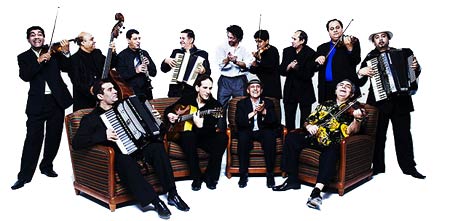Remember Liam O’Connor, the Irish button accordionist who set the Guinness record for “Fastest Fingers in the World” last year? I’d like to see him go up against Alexander Dmitriev, shown here performing Nikolai Rimsky-Korsakov’s “Flight of the Bumblebee” on the bayan (a Russian chromatic accordion). My fingers got tangled up just watching it.
Japanese Accordion/Ukulele Duel
We’ve mentioned jazz accordion here before, but never jazz ukulele, and certainly never the two together. However, this clip of swingin’ Japanese ukulele duo TTCafe (with guests) covers it all. A fairly straightforward rendition of the Stevie Wonder classic “Sir Duke” morphs into a spirited give-and-take between Kunitaka Watanabe on accordion and Takashi Nakamura on ukulele.
Piano Accordion Buying Guide
From time to time, we get email from people looking for advice on buying their first accordion. I try to give them an overview of the instrument, what I found helpful when I was starting out, etc., but it’s difficult to convey all of that information through email.
Recently, though, I found this video guide to buying a piano accordion from the guy who runs Liberty Bellows in Philadelphia. He covers the basics — keyboard sizes, button layouts, numbers of reeds, bellows condition — and how they relate to pricing. Experienced players won’t hear anything new, but if you’re just getting started and want to know what to look for when buying your first accordion (new or used), it’s definitely worth checking out.
The Return of Taraf de Haidouks

Taraf de Haïdouks — which translates to “band of honorable outlaws” (a “haidouk” is a Robin Hood-like hero of Romanian folklore) — are a group of virtuoso gypsy musicians from the Romanian village of Clejani. Called the “world’s greatest gypsy band” by some, this colorful cast of characters has charmed audiences worldwide (actor Johnny Depp is one of their biggest fans).
With musicians ranging in age from their twenties to their seventies, the Tarafs play intense, rhythmically complex music at a breakneck pace on fiddles, cymbaloms, and accordions. They’ve also earned a reputation as free spirits, drinking reporters under the table and breaking into song at all hours of the night.
They have a new album — their first studio album since 2001’s Band of Gypsies and the death of their star violinist Neacsu Neculae — due out next month called Maskarada. This time around, the Taraf take on classical music with “re-gypsyfied” renditions of works by Khachaturian, Bartok, Liszt, de Falla, Albeniz, and others.
I’ve seen clips of Taraf de Haidouks where as many as twenty musicians are involved (mostly violins and accordions), but this live performance of “Rustem” features just a quartet — violin, cymbalum, upright bass, and one manic accordion:
Trondheim Accordion Ensemble
The Norwegians clearly know how to do classical music right — with accordions! The Trondheim Accordion Ensemble aims to bring “youthful freshness and vibrant musical joy” to baroque music, as shown in this video of the group performing Bach’s Brandenburg Concerto No. 3, Allegro.
Need more accordion? Follow us on Twitter, Facebook, or email.
On the Edge With Kimmo Pohjonen
 If you prefer accordion music that doesn’t play by the rules, check out Paul Sullivan’s excellent biography of Finnish avant-garde/experimental accordionist Kimmo Pohjonen. Playing a 5-row chromatic accordion, Pohjonen uses electronic effects like samples and loops, as well as heavy doses of improvisation, to push his instrument into uncharted territory. In addition to his solo work, he has collaborated with percussionist/sampler Samuli Kosminen, the Kronos Quartet, and former King Crimson members Pat Mastelotto and Trey Gunn.
If you prefer accordion music that doesn’t play by the rules, check out Paul Sullivan’s excellent biography of Finnish avant-garde/experimental accordionist Kimmo Pohjonen. Playing a 5-row chromatic accordion, Pohjonen uses electronic effects like samples and loops, as well as heavy doses of improvisation, to push his instrument into uncharted territory. In addition to his solo work, he has collaborated with percussionist/sampler Samuli Kosminen, the Kronos Quartet, and former King Crimson members Pat Mastelotto and Trey Gunn.
“Sometimes it can be a bit strange for people that an accordion player is doing the kind of stuff that I am doing. But I’m getting such good feedback… I hear comments like, ‘I have never liked accordion, and this is the first time that I’ve liked some accordion music.’ And that is the best comment that you can get.”
According to his site, Pohjonen’s mission is “to expand the capabilities, sound, performance, scope and experience of the accordion in many different settings to levels never before seen or heard.” Judge for yourself — here’s a video clip of Pohjonen performing solo in 2002:
The Big Joe Polka Show
I like to think of The Big Joe Polka Show as polka’s answer to American Bandstand. Just replace the TV studio with a large plywood dance floor in an Elk’s Lodge, the awkward teens with polka dancing seniors, and Dick Clark with the charming “Big Joe” Siedlik and his loud, accordion-patterned vests.
For more than 25 years, Big Joe was a polka radio king, spinning a popular mix of Polish, Czech and German polka records for listeners in the Midwest. After retiring from radio, he moved to television and now showcases live polka bands and dancers on his program which airs nationwide on RFD-TV, “Rural America’s Most Important Network.”
Later this month, Big Joe will film a series of shows at the RFD-TV Theater in Branson, Missouri. It’s a big deal for the bands chosen to perform and they’re coming from all over the country — the Polka Chips from Alaska, Smilin’ Scandinavians from Washington, Phocus from Buffalo, and many more.
One of polka’s biggest promoters, Big Joe likes to say that “polka tots make polka teens, and polka teens make adult human beings.” This clip is proof of that, as Big Joe welcomes (and teases) the younger members of Colorado’s Polka Nuts:
Vallenato Legend Festival Video
Vallenato is a popular accordion-based folk music from the Caribbean region of Colombia, influenced by African, European, and Colombian rhythms and sounds. Right now in Valledupar, the annual Festival de la Leyenda Vallenata is taking place, and it includes a contest where vallenato musicians compete in categories for best professional accordionist, amateur accordionist, and more.
Juan, a reader from Colombia, forwarded me this excellent video from a previous festival, featuring the fast fingers of Sammy Ariza Ramos. Don’t skip the caja (drum) and guacharaca (percussion stick) solos — they’re incredible, too.
Jamming With The Yankovics
They shared a last name and a love of the accordion but, contrary to popular belief, polka king Frankie Yankovic and parody king Weird Al Yankovic weren’t actually related. In 1986, though, the two joined forces for this hilarious segment during the half-hour special Weird Al’s Guide to the Grammys. In it, Weird Al conducts a brief interview with Frankie (who was up for the first-ever Best Polka Album award that year) and then the two perform a polka medley of Record of the Year nominees including “Born in the USA” and “We Are The World”.
More Eurovision Madness: Verka Serduchka
Like American Idol, the annual Eurovision Song Contest is one of my favorite musical guilty pleasures. Ridiculously cheesy songs delivered with over-the-top drama, usually in a language I can’t understand… what’s not to like?
I wrote about Israel’s controversial entry, “Push the Button”, last month but today I came across some lighter fare. “Dancing Lasha Tumbai” is the Ukraine’s entry — a high-energy dance number (with accordion, of course) sung by a cross-dressing guy who calls himself Verka Serduchka. He reminded me of San Francisco’s accordion-playing drag queen, Kielbasia, but if she had stayed in the old country and become a pop diva.
